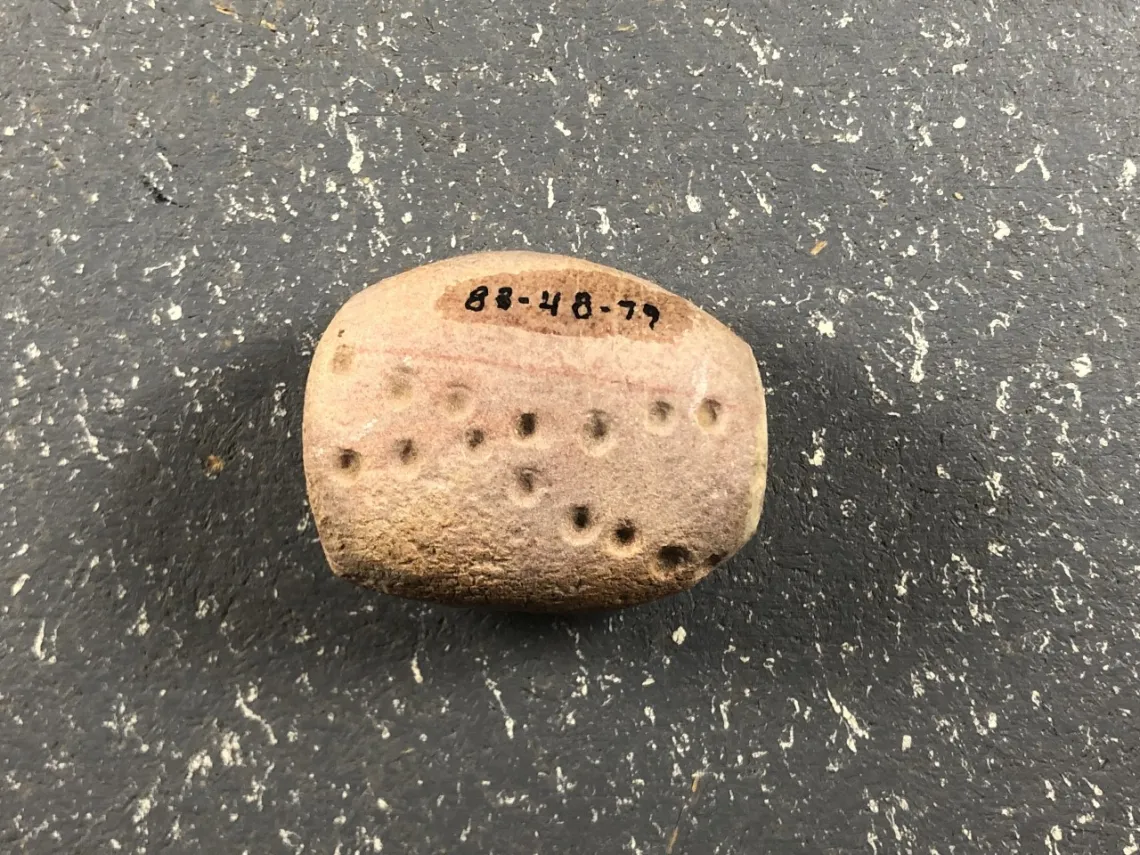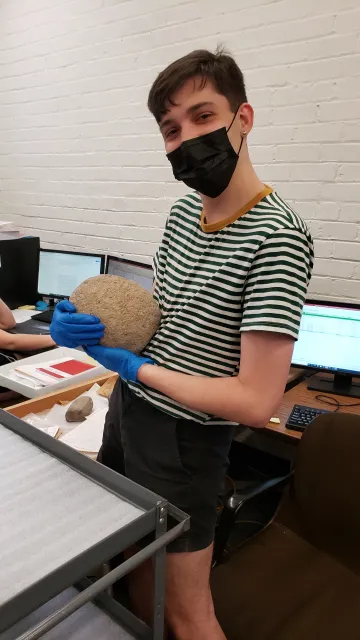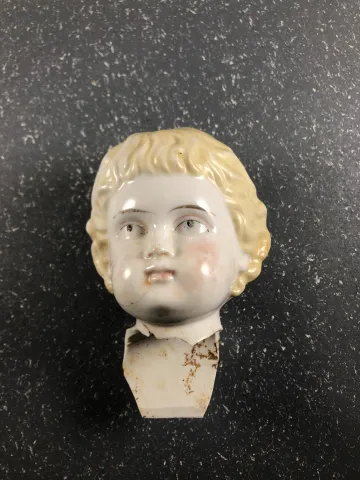
AP-1988-48-79: a small, oval shaped, pink quartzite pebble with a series of small concavities in an X-shaped pattern drilled into each side.
By Tony Moreno ASM Archaeological Repository Collections Management Intern Spring 2022
When I came into my first day interning at the Arizona State Museum Repository my goals were gaining hands-on experience with archeological artifacts, gaining a better understanding of the inner workings of museum archives, and learning the basics of how to use databases. My task during my time in the Repository consisted of assessing and inventorying the Repository's backlog of catalog collections. This inventory project involved me going through project collections, verifying locations and statuses of in-process collections, and entering all information into a database. Part of this process required cross referencing and verifying each object with the project report and ASM's online Collections Information System (CIS) database. Through this process I assessed 59 collections with a total combined object count of 1,304.
Before I became an intern at the ASM Repository, I had taken multiple archaeology classes at the University of Arizona. I learned many things in these classes, but something that they all lacked was hands-on experience with artifacts and archeological reports. This internship gave me extensive hands-on experience and taught me much more about how to handle artifacts, the names for different kinds of artifacts, and the various kinds that were used by the occupants of the American Southwest. My archaeological vocabulary also expanded immensely; I had to learn the names of different kinds of artifacts to be able to identify them correctly when assessing a collection. Something valuable that I gained from my internship at the ASM Repository was that I now feel more invested and interested in archeology as a field. The objects listed below are some of the objects that really captured my interest and have contributed to this sense of feeling overall more invested in archaeology.
The first object that piqued my interest was an object that was simply identified as a possible gaming piece (AP-1988-48-79; Figure 1) by the archeologists who excavated it from the Corona De Tucson Project (AP-1988-48). The report for the project described it as a “small, oval-shaped, pink quartzite pebble [that] has been heavily ground to shape and smoothed on all surfaces,” with a “series of small concavities in an X-shaped pattern has been drilled into each side, 14 on one surface, and 15 on the other” (Huckell et al., 1987). Later in the report it is said that many small objects like this have been called gaming pieces, but this object does not show any resemblance to the many stone disks and balls used as gaming pieces and at the point of the report being written, the function of this object is unknown (Huckell et al., 1987). I found this object to be particularly interesting due to the mystery behind it. Why was this object made? Who was it made by? What was the purpose? I believe this exemplifies the curiosity of archeology, to understand how and why humans made certain objects. This object sparked my curiosity and made me want to learn more about it. Given the opportunity, I would investigate how the form and function of other objects that have been identified as gaming pieces and compare that with this object to better understand what this object might be.

Antonio Moreno with "stone ball" (AP-2001-200-14).
Another object I inventoried that appeared to be a bit of a mystery was an object only referred to as a “Stone Ball” (AP-2001-200-14; Figure 2) in the repository database from the Lee Fratt Archeological Testing in Green Valley collection, AP-2001-200. When I came across this object in its tray, it was unlike any object I had yet seen in the repository collections. It was simply a large round, smooth, heavy rock! The project report indicated that this object came from archeological testing in Green Valley, Arizona. This object is not specifically identified as a stone ball in its report, but is described at length, which by the ASM Repository’s rules means that it should be cataloged. The report states that it is one of three large rocks, although it is not indicated whether all the large rocks are the same size as the large rock found in the collection, that were recovered from the site. Apparently, these rocks were water-worn cobbles, and not smoothed by humans (Fratt, 2000, p. 36). Most interestingly and possibly the main reason it was highlighted, the report states that “such large cobbles do not appear in the area [that was excavated] naturally, and they are presumed to have been brought onto the site by the former occupants for some purpose” (Fratt, 2000, p. 36). Other than the information that I’ve quoted the report has no other information on this mysterious object like where the rock originates, what they mean by water-worn and so on. Like the previous object this raises many questions! Where did these stones originate and why did the occupants bring them here? What purpose did they serve? When objects like this and the one previously mentioned are found and are such apparent mysteries, I cannot help but pay attention to them! If I were to pursue research on this interesting object, I would investigate the type of rock that the object is made of, where this object is found, and what an object like this might have been used for. I might also seek getting in contact with those who conducted this dig and the report authors because the way they wrote the report indicates they may have some answers to some of my questions! I find this object so fascinating because of the mystery behind it as well as the fact that it is unlike anything I have seen in the Repository as there are very few objects as large or as heavy as this object that are not considered oversized ground stone.

AP-1992-80-90: A hollow porcelain doll head with blonde hair.
The last few objects I would like to discuss are from the excavation of Block 83 in Tucson, Arizona (AP-1992-80). As a lifelong resident of Tucson, this collection was particularly interesting to me, because it lies squarely at the intersection of my love for my hometown and my growing interest in the field of archaeology. This excavation includes many objects found in this block that date back to the turn of the century, and thus are tied to Tucson's rich past.
The object from this collection I would like to highlight is a doll's head (AP-1992-80-90; Figure 3). The article written for this site described the object as a “hollow head with painted eyebrows and porcelain teeth that were separately applied to the inside of the mouth” (Mabry et al., 1994). This object represents to me the intricate past of this area, and the intricate past that archeology can uncover. The collection this object is a part of has countless objects like this one that together show an intricate past of the city of Tucson, and the people who used to live in it.
These objects, and the collections they came from, made me more interested in archeology than I ever thought possible. They prompted me to ask archeological questions I would have thought to ask without having hands-on experience with archaeological objects, and I believe that is the greatest lesson I gained from my time interning at the Repository.
Works Cited
Huckell, B. B., Tagg, M. D. Huckell, L. W. (1987) The Corona De Tucson Project: Prehistoric
Use of a Bajada Environment. ASM Archaeological Series, 174. 1-365.
Mabry, J. B., Ayres, J. E., Chapin-Pyritz, R. L. (1994) Tucson at the Turn of the Century: The Archaeology of Black 83 (Report No. 92-10) Center for Desert Archeology.
Fratt, L. (2000) Results of Archeological Testing of 5.6-Acres that includes Part of The Continental Site (AZ:EE:1:32(ASM)), In Green Valley, Pima County, Arizona (Report No. 99-03) Tierra Archeological and Environmental Consultants.





